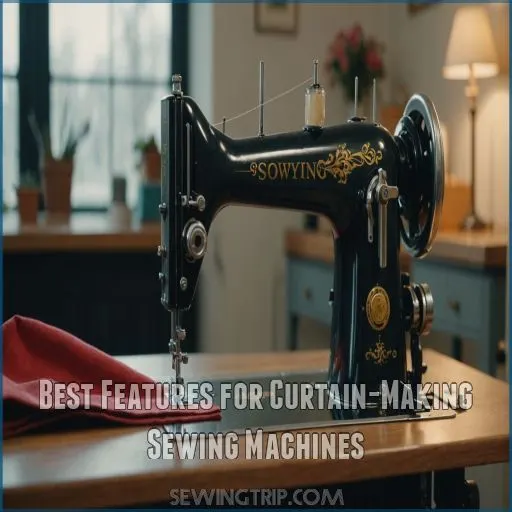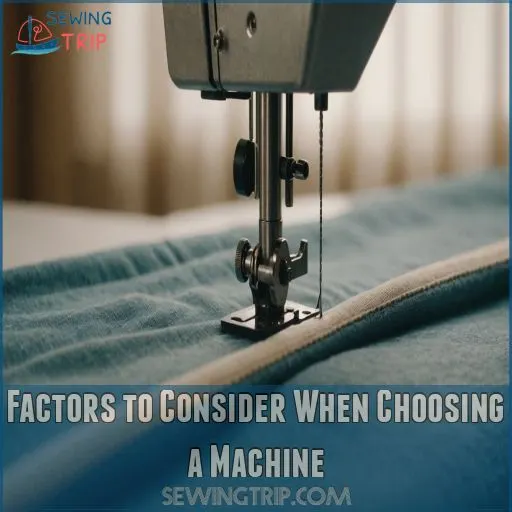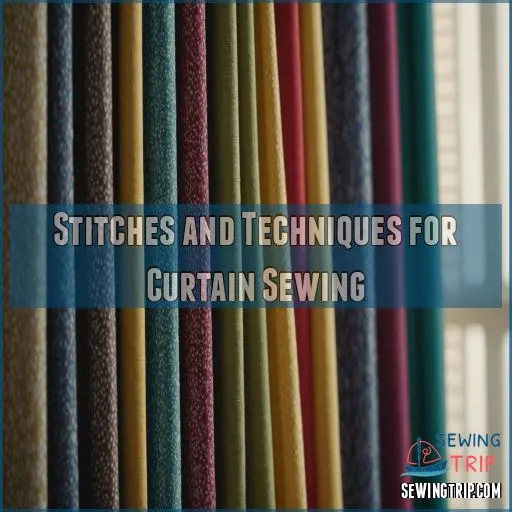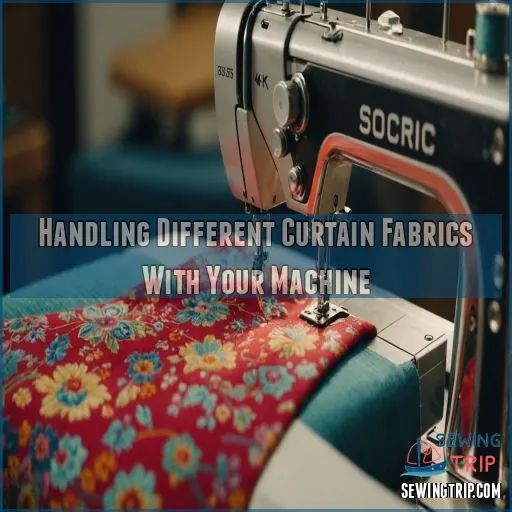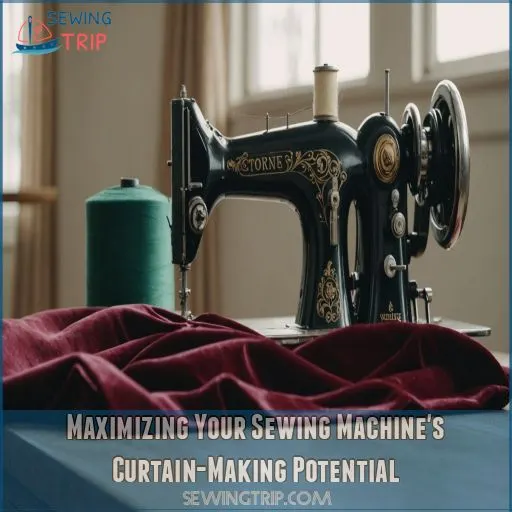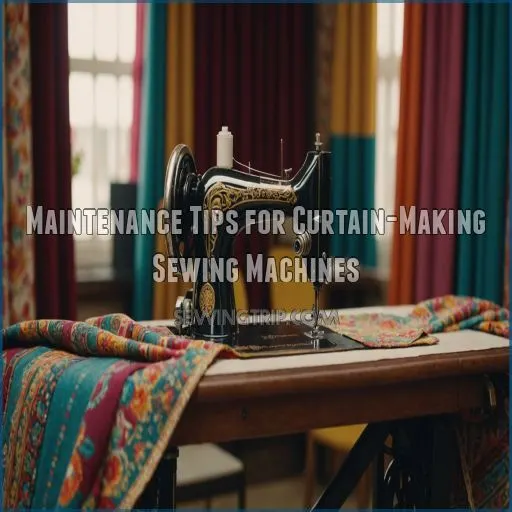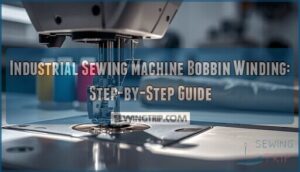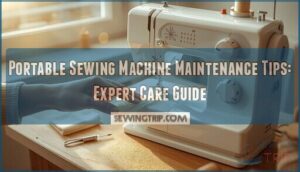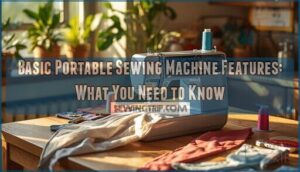This site is supported by our readers. We may earn a commission, at no cost to you, if you purchase through links.
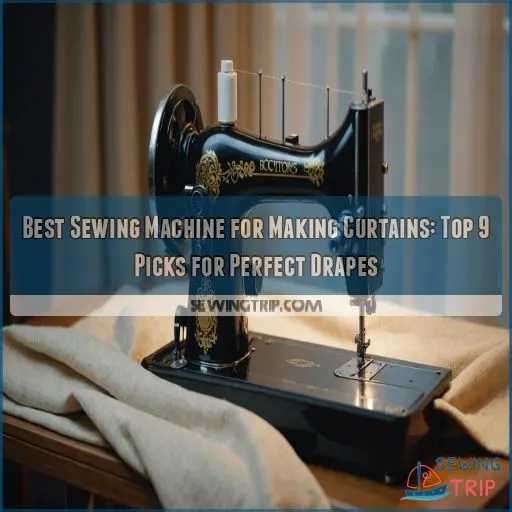
For power and precision, the Brother CS6000i is a standout with its user-friendly features and wide extension table, perfect for large curtain fabric.
If you’re tackling thick materials, the Janome HD3000 offers the robust performance you’d expect from a heavy-duty option. Fancy something budget-friendly and vibrant?
The Singer Heavy Duty might fit the bill with its powerful motor and timeless reliability. Each machine lets you waltz through curtain projects with ease, but which will you choose for your next sewing adventure?
Table Of Contents
- Key Takeaways
- Best Features for Curtain-Making Sewing Machines
- Factors to Consider When Choosing a Machine
- 9 Best Sewing Machines for Making Curtains
- 1. Brother CS6000i Sewing and Quilting Machine
- 2. Janome HD3000 Heavy Duty Sewing Machine
- 3. Singer Heavy Duty Sewing Machine
- 4. Brother XM2701 Sewing Machine
- 5. Heureux Computerized Sewing Machine
- 6. Singer 9960 Sewing Quilting Machine
- 7. Portable Sewing Kit for Quick Repairs
- 8. Brother Project Runway Sewing Machine
- 9. Janome HD1000 Heavy Duty Sewing Machine
- Stitches and Techniques for Curtain Sewing
- Handling Different Curtain Fabrics With Your Machine
- Maximizing Your Sewing Machine’s Curtain-Making Potential
- Maintenance Tips for Curtain-Making Sewing Machines
- Frequently Asked Questions (FAQs)
- Conclusion
Key Takeaways
- When picking a sewing machine for curtains, look for a powerhouse that can handle thick fabrics with ease, such as a heavy-duty machine with a powerful motor, like those found in top-rated heavy-duty sewing machines(top-rated heavy-duty sewing machines)
. The Janome HD3000 or Singer Heavy Duty can be your trusty steed, galloping through layers of material without breaking a sweat. These machines are built like tanks, perfect for tackling those hefty drapery projects.
- Consider features like an automatic needle threader and a built-in thread cutter as your new best friends. They will save you from squinting at needles and fumbling for scissors, letting you whip up those perfect curtains in no time. It is like having a tiny robot assistant that makes curtain-making a breeze.
- Remember, space is your ally. An extension table provides the elbow room you need when you’re wrestling with large fabric panels. Think of it as a dance floor for your sewing machine, giving you more freedom to waltz through your projects without tripping over yourself.
- Don’t overlook the noise factor! A sewing machine that purrs like a contented kitten can make your sewing sessions peaceful and enjoyable, especially during those late-night creative marathons. It is the difference between serenity and feeling like you are in a rock concert!
Best Features for Curtain-Making Sewing Machines
If you’re thinking about making curtains, you’ll want a sewing machine that’s up to the task.
Let’s explore the must-have features that’ll make your curtain-making journey a breeze, from automatic needle threaders to built-in buttonhole capabilities.
Automatic Needle Threader
With an automatic needle threader, you’ll wave goodbye to squinting and fumbling.
This nifty feature is a game-changer for curtain makers, especially when you’re working with thick fabrics or intricate designs.
It’s like having a tiny robot assistant that guides the thread through the eye of the needle, saving you time and frustration. You’ll be stitching up a storm in no time!
Built-in Thread Cutter
You’ve mastered the needle threader, now let’s cut to the chase!
A built-in thread cutter is your new best friend for curtain-making. It’s like having a personal assistant right at your fingertips, snipping threads with precision and speed.
No more fumbling for scissors or leaving messy thread tails. This nifty feature saves time and keeps your workspace tidy, letting you focus on creating those perfect drapes .
Walking Foot
A walking foot is your secret weapon for perfect curtain seams. It guides multiple layers of fabric through your machine, acting like a faithful companion, and prevents puckering and shifting, saying goodbye to uneven stitches!
This nifty attachment works in tandem with your machine’s feed dogs to ensure even fabric movement.
Whether you’re tackling heavy drapes or slippery sheers, the walking foot keeps your curtain project on track.
Extension Table
When you’re wrestling with yards of curtain fabric, an extension table becomes your best friend. This nifty accessory expands your sewing surface, giving you the breathing room to manage those bulky drapes without a fuss.
A good sewing machine like the Janome HD3000, which boasts a sturdy metal frame, can make the most of an extension table. Machines with automatic needle threading capabilities can also save you time and effort.
Look for a table that’s sturdy and spacious, with enough throat space to accommodate your curtain’s width. It’s like giving your sewing machine a dance floor – more room to show off its moves!
Needle Up/Down Feature
The needle up/down feature is a game-changer for curtain-making. It’s like having a third hand!
You can easily adjust stitches and control tension by stopping the needle in your preferred position.
This nifty trick lets you pivot fabric smoothly around corners, manipulate layers without shifting, and finish seams with precision.
Whether you’re tackling straight stitches or zigzags, this feature gives you the control you’ve always dreamed of.
Automatic Buttonhole Feature
Mastering the art of buttonholes can elevate your curtain-making game.
An automatic buttonhole feature is your secret weapon for adding professional-looking curtain ties or fastenings . This nifty function takes the guesswork out of creating perfect buttonholes, offering:
- Consistent sizing for a polished look
- Time-saving automation
- Versatility for different fabric types
- Stress-free execution, even for beginners
Say goodbye to wonky, hand-sewn buttonholes and hello to crisp, elegant curtains that’ll make your neighbors green with envy!
Factors to Consider When Choosing a Machine
Picking the right sewing machine for making curtains is a big deal, and there are a few key factors that will make your life easier.
From stitch speed to throat space, we’ll break down the essential elements you should keep in mind as you hunt for your dream machine.
Usage and Future Sewing Needs
Considering your sewing habits and future aspirations is key when selecting a curtain-making machine. You’ll want a versatile workhorse that can handle your current projects and grow with your skills.
Let’s break down some factors to keep in mind:
| Usage Factor | Beginner | Advanced |
|---|---|---|
| Frequency | Occasional | Frequent |
| Project Scope | Simple curtains | Complex drapes |
| Fabric Types | Light to medium | Heavy, varied |
Remember, your dream machine should be your trusty sidekick, ready to tackle anything from breezy sheers to hefty blackouts.
Stitch Speed for Heavy Fabrics
When sewing curtains, you’ll want a machine that can handle heavy fabrics without breaking a sweat.
Aim for at least 800 stitches per minute to breeze through those long seams (Source). Remember, power isn’t just about speed – it’s about maintaining consistent stitches through thick layers.
Think of your machine as a trusty steed, galloping effortlessly through yards of drapery fabric.
Adjustable speed control lets you rein in that power for precision work.
Mechanical Vs. Computerized Options
While stitch speed is important, let’s chat about mechanical vs. computerized machines. It’s like choosing between a reliable old pickup truck and a fancy sports car.
Mechanical machines are the workhorses – durable, easy to repair, and budget-friendly .
Computerized options, though pricier, offer more bells and whistles like automatic tension adjustment and built-in stitch libraries (Source).
Your choice depends on your comfort with technology and desire for features.
Throat Space for Wide Curtain Fabric
The throat space of your sewing machine can make or break your curtain-making experience.
It’s like having elbow room in a crowded subway car – you need enough space to maneuver those wide panels comfortably.
A generous throat space allows you to handle bulky curtain fabrics with ease, preventing frustrating fabric bunching and ensuring smooth stitching.
Look for machines with at least 6-8 inches of throat space for the best curtain-making comfort.
Foot and Needle Compatibility
You’ve got the throat space sorted, now let’s talk about your machine’s fashion sense. Choosing the right foot and needle combo is like picking the perfect outfit for your curtain fabric. Just as you wouldn’t wear flip-flops to a black-tie event, you need to match your needle size and foot type to your fabric weight.
This pairing makes sure smooth sailing through delicate sheers or heavy upholstery alike. To avoid issues like dropped hems and puckering, make sure your machine’s tension settings and needle type are suitable for the fabric, making adjustments as needed.
Additionally, consider the unique characteristics of your fabric, such as viscose linen, which requires careful handling and precision cutting.
Noise Level During Operation
After considering foot and needle compatibility, let’s talk about the noise factor.
Sewing can be a peaceful hobby, but a loud machine might turn it into a headache-inducing chore.
When choosing your curtain-making companion, pay attention to its sound levels. Some machines purr like contented kittens, while others roar like angry lions.
A quieter machine can make your sewing sessions more enjoyable, especially if you’re working late into the night with a machine that is as quiet as a contented kitten.
9 Best Sewing Machines for Making Curtains
You’re in for a treat as we explore the top 9 sewing machines that’ll make your leather sewing machine dreams come true
.
Whether you’re a seasoned pro or just starting out, these machines offer the perfect blend of features to help you create stunning window treatments with ease.
1. Brother CS6000i Sewing and Quilting Machine
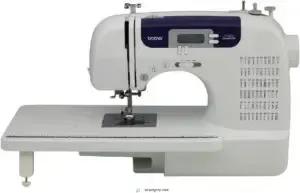
For curtain-making enthusiasts, the Brother CS6000i is a game-changer.
With 60 built-in stitches, including decorative options and seven auto-size buttonholes, you’ll have plenty of creative freedom .
This user-friendly machine boasts an automatic needle threader and top-loading bobbin, making setup a breeze.
The included wide table is perfect for managing bulky curtain fabrics, while the LCD display lets you select stitches with ease.
Don’t worry about portability – the hard protective case has got you covered. Plus, with a 25-year warranty and free lifetime support, you’re set for countless curtain projects.
Best For: The Brother CS6000i is best for beginner sewists and quilters, especially those interested in curtain-making and who value ease of use and portability.
- Includes a wide table for working with larger projects.
- Boasts a 25-year warranty and free lifetime support.
- Has a user-friendly interface with an LCD display and automatic needle threader.
- The needle threader can be difficult for some users.
- The work light is weak.
- The machine does not have a cut thread button.
2. Janome HD3000 Heavy Duty Sewing Machine
The Janome HD3000 is a powerhouse for curtain-making enthusiasts.
This heavy-duty machine boasts a sturdy metal frame and a high-lift presser foot, perfect for tackling thick fabrics (Source). You’ll breeze through your projects with its built-in needle threader and one-step buttonhole feature.
The adjustable presser foot pressure allows you to fine-tune your stitching for various curtain materials. While it offers fewer built-in stitches than some competitors, its 18 options cover all your curtain-making needs.
Just be prepared for a slight learning curve with the multiple dials – but hey, mastering them is half the fun!
Best For: The Janome HD3000 is best for sewers who need a durable machine to handle heavier fabrics like those used for curtains.
- Heavy-duty construction: Handles thick fabrics with ease.
- High-lift presser foot: Makes it easy to work with bulky projects.
- Adjustable presser foot pressure: Allows you to fine-tune your stitches for different fabrics.
- Multiple dials: Can be overwhelming for some users.
- Short foot pedal cord: May limit your sewing space.
- No speed control: You can’t adjust the sewing speed.
3. Singer Heavy Duty Sewing Machine
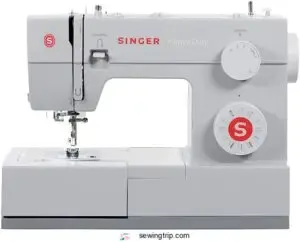
When you’re ready to start making curtains, the Singer Heavy Duty Sewing Machine stands out as a powerful tool for handling thick fabrics.
With its robust 1,100 stitches-per-minute speed and 60% stronger motor, you’ll breeze through even the heaviest drapery materials.
This workhorse boasts 23 built-in stitches, including an automatic buttonhole feature, perfect for adding those finishing touches to your curtains.
The automatic needle threader is a game-changer, saving your eyes from strain and frustration.
Plus, its metal frame guarantees durability, making it a reliable companion for all your curtain projects.
Best For: This machine is best for sewers who work with heavy fabrics and need a durable, powerful machine.
- High-speed sewing for quick project completion.
- Powerful motor for handling thick seams and heavier fabrics.
- Automatic needle threader for ease of use.
- May be overkill for sewers who primarily work with lightweight fabrics.
- Can be heavy and bulky to move around.
- Some users may find the 90-day warranty to be too short.
4. Brother XM2701 Sewing Machine
Versatility meets user-friendliness in the Brother XM2701, a sewing machine that’s perfect for curtain-making enthusiasts of all levels, offering a variety of stitch options and variety
. You’ll love its 27 built-in stitches, including decorative and blind hem options, ideal for adding flair to your drapes.
The automatic needle threader and jam-resistant drop-in top bobbin make setup a breeze, while the free arm allows you to easily tackle narrow sections of your curtains.
Additionally, the Brother XM2701’s adjustable presser foot pressure is a standout feature, allowing you to customize pressure for different fabric types, ensuring even feeding and reducing puckering, similar to the Automatic Presser Foot Pressure found in other Brother models.
With six sewing feet and a detailed instructional DVD, you’ll be whipping up professional-looking window treatments in no time. It’s like having a personal sewing tutor right at your fingertips!
Best For: The Brother XM2701 is best for beginners and experienced sewers who want a versatile and easy-to-use machine for a wide range of sewing projects, including curtains.
- 27 built-in stitches, including decorative and blind hem options, for various sewing projects.
- Automatic needle threader and drop-in top bobbin for easy setup.
- Adjustable presser foot pressure for different fabric types, minimizing puckering.
- Some users have reported minor issues with the machine, although overall reviews are positive.
- Thread tension can be tricky to master without visual guidance.
- It’s recommended to use polyester thread to prevent the machine from gunking up.
5. Heureux Computerized Sewing Machine
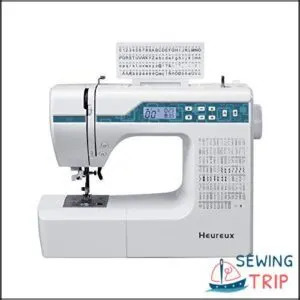
A powerhouse in curtain-making, the Heureux Computerized Sewing Machine brings your drapery dreams to life.
With 200 built-in stitches, you’ll have a treasure trove of options for decorative touches.
Need to embroider your curtains? This machine’s got you covered.
The automatic needle threader and top-loading bobbin system will save you time and frustration, letting you focus on creating stunning window treatments.
Plus, its quiet operation means you can sew late into the night without disturbing your household.
Ready to take control of your curtain game?
Best For: This machine is best for sewers of all levels who want a versatile machine for a variety of projects, including curtains, clothes, and accessories.
- 200 built-in stitches offer a wide range of options for decorative and functional sewing.
- Automatic needle threader and top-loading bobbin system make sewing faster and easier.
- Quiet operation allows for sewing without disturbing others.
- May require an embroidery foot for embroidery functions.
- Some users report issues with the bobbin.
- Customer support response time can be slow.
6. Singer 9960 Sewing Quilting Machine
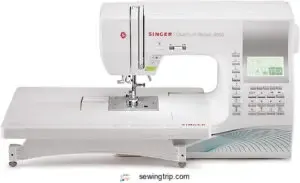
Packed with features, the Singer 9960 is a powerhouse for curtain making.
You’ll love its 600 built-in stitches and blazing speed of 850 stitches per minute. This machine’s got your back with an automatic needle threader and thread cutter, saving you time and frustration.
The extension table gives you plenty of room to wrangle those big curtain panels. Plus, with 13 one-step buttonholes, adding curtain ties is a breeze.
Whether you’re a newbie or a pro, this machine’s user-friendly interface makes creating stunning drapes a walk in the park.
Best For: Sewing enthusiasts of all levels who want a feature-rich machine for crafting curtains, home decor projects, and more.
- Packed with features, including Automatic Needle Threading and a thread cutter for ease of use.
- The extension table provides ample space for large projects.
- Many positive user reviews highlight the machine’s speed, quiet operation, and ease of use.
- Some users find the stitch setting interface a bit challenging to navigate.
- Lack of a 1/4" seam foot, which is a common requirement for quilting.
- The 90-day warranty is shorter than some other sewing machines on the market.
7. Portable Sewing Kit for Quick Repairs
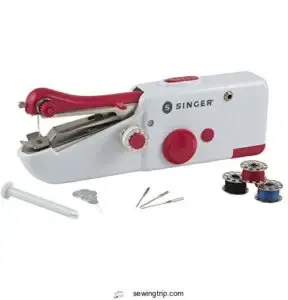
The handyman’s secret weapon, a portable sewing kit, can be your curtain-making ally in a pinch.
While it won’t replace a full-sized machine, Singer’s cordless, handheld mender is perfect for quick fixes and on-the-spot adjustments. You’ll appreciate its single-thread feed for basting or temporary repairs on lightweight fabrics.
The kit comes loaded with threads, bobbins, and needles, so you’re always ready to tackle small curtain emergencies. Just remember, it’s battery-powered (batteries not included), so keep some AAs on hand for those unexpected curtain crises!
Best For: This portable sewing kit is best for beginners and those who need a quick and easy way to mend lightweight fabrics.
- Easy to use, even for beginners.
- Durable repairs that last.
- Includes a variety of needles and threads for different fabrics.
- Only one stitch type, which can be challenging for certain fabrics.
- Stitches can come undone if instructions aren’t followed precisely.
- May not work well with stretchy or thick fabrics.
8. Brother Project Runway Sewing Machine
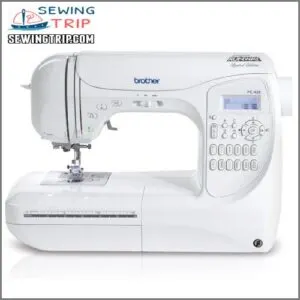
In light of your curtain-making dreams, the Brother Project Runway PC420PRW is a game-changer.
You’ll find yourself in stitching heaven with its 294 built-in stitches and 10 one-step buttonhole styles.
This powerhouse boasts an 850 stitches-per-minute speed, perfect for whipping up those floor-length drapes in no time.
With features like the My Custom Stitch and adjustable presser foot pressure, you’re in the driver’s seat of your curtain creation.
Plus, the dual LED workspace lighting makes sure you won’t be left in the dark during late-night sewing sessions.
Best For: The Brother Project Runway PC420PRW is ideal for experienced sewers looking for a powerful and versatile machine.
- Offers a wide range of stitches and features for a variety of sewing projects.
- Provides a fast sewing speed for efficient project completion.
- Includes helpful features like custom stitch design and adjustable presser foot pressure.
- May not be suitable for beginners due to its advanced features.
- Requires good quality thread to prevent snapping or shredding.
- Defaults to left needle position, which may require manual resetting.
9. Janome HD1000 Heavy Duty Sewing Machine
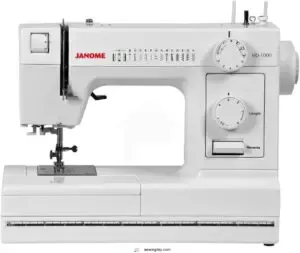
Something about the Janome HD1000 just screams reliability for curtain-making novices and pros alike.
This heavy-duty machine is your trusty sidekick, with 14 built-in stitches and a cast aluminum body that laughs in the face of thick fabrics.
It’s got an automatic needle threader that saves your eyes and a front-loading bobbin reminiscent of the golden days of sewing.
It’s like finding a hidden gem in your grandma’s closet—durable, easy to use, and ready to handle whatever curtain project you throw its way.
Best For: The Janome HD1000 is best for sewers who need a machine that can handle thick fabrics and heavy-duty projects.
- Durable construction with a cast aluminum body.
- Handles thick fabrics like denim and multiple layers with ease.
- Comes with a variety of accessories, including a hard case for travel.
- The on/off switch is located behind the foot controller, which can be awkward to reach.
- Bobbin winding requires manual disengagement of the stop motion.
- Some users have reported issues with the handwheel after extended use.
Stitches and Techniques for Curtain Sewing
In curtain sewing, mastering a variety of stitches can transform your drapery from drab to fab.
Whether you’re tackling hems or adding decorative flair, understanding each stitch type will make your curtains the true showstopper of your home décor, and with that, the true potential of drapery.
Straight Stitch for Main Seams
Straight stitch is the workhorse for curtain sewing, creating clean, secure seams. Use it for the main panels, hems, and any other straight edges. Adjust your stitch length to 2.5-3.5 mm for best results.
Key tips:
- Maintain proper tension control for a smooth finish.
- Choose a needle size suited to your fabric weight.
- Leverage the free arm for sewing narrow areas.
- Take it slow on delicate fabrics to prevent puckering.
Zigzag Stitch for Edge Finishing
Ever tried adding a zigzag stitch to your edge finishing techniques?
This versatile stitch, often overlooked, protects against fraying while handling delicate fabrics.
Adjust the stitch width to match your curtain’s fabric type for a professional look.
You might think sergers are a must, but your trusty sewing machine can zigzag through those edges like a champ—no tassels required!
Buttonhole Stitch for Curtain Ties
You’ve mastered edge finishing, now tackle buttonhole stitches for curtain ties! Picture crafting "granny chic" ties with perfect buttonhole placement on your sewing machine.
Whether you’re considering delicate fabrics or robust ones, here’s your checklist:
- Buttonhole types
- Tie design ideas
- Fabric considerations
- Alternative closures
- Precision with a buttonhole stitch
Style your curtains with flair, avoiding fabric disasters!
Blind Hem Stitch for Invisible Hems
When mastering the perfect drape, don’t overlook the blind hem stitch for invisible hems.
This technique’s your secret weapon for keeping hems discreet, especially on delicate fabrics.
Adjust your sewing machine’s settings, ensuring tension is just right. Automatic needle threading saves time and helps maintain precision.
With practice, your curtains will look like a pro’s handiwork—just without the price tag.
Decorative Stitches for Embellishments
Extending from an invisible hem finish, decorative stitches open a creative playground for your curtains. Adding personality with your sewing machine, these stitches bring flair to otherwise plain panels.
- Embroidery stitches: Think of them as accessories, dressing up your drapes.
- Free-motion embroidery: Let your creativity shine.
- Stitch patterns: Endless designs await.
- Embellishment ideas: Pearls, sequins, anyone?
Handling Different Curtain Fabrics With Your Machine
When handling different curtain fabrics with your sewing machine, it’s all about adapting to the material’s quirks.
Whether you’re taming sheer fabrics with gentle tension or defeating thick fabrics with heavy-duty needles, your machine becomes a trusty sidekick in your curtain-making adventure.
Adjusting Tension for Sheer Fabrics
Taming sheer fabrics can feel like threading a needle in the dark, but adjusting sewing machine tension works wonders.
Lighten the top tension slightly—your sewing BFF, Robert Allen, couldn’t have done it better—and don’t forget the bobbin tension.
Pair with a fine needle and lightweight thread for silky, drama-free drapes.
Automatic tension control? That’s your magical curtain fairy!
Using Heavy-Duty Needles for Thick Fabrics
You’ve mastered sheer fabric tension; now tackle thick fabrics with heavy-duty needles.
Choose a size fit for fabric weight—oversized for thick, stout for lighter layers. Imagine this: sewing through thick curtains with flimsy needles is like driving on a flat tire.
Stitch selection becomes a breeze with the right domestic sewing machine, and the right needle type empowers your sewing machine to conquer any curtain challenge like a quilt sewing machine
!
Selecting Appropriate Thread Types
Choosing the right thread can make or break your curtain project!
Think of thread weight like the conductor keeping harmony between fabric texture and sewing tension.
For delicate fabrics, opt for lighter threads—like choosing Robert Allen for refined style.
Match thread color for seamless beauty and balance complexity with practicality to make sure your sewing machine sings, not screeches, through fabric. For the best results, consider the seamless beauty of your curtains.
Adjusting Presser Foot Pressure
Adjusting presser foot pressure is really important when sewing curtains, especially with varied fabric thicknesses like Robert Allen’s designer textiles.
If your delicate fabrics bunch up or thick seams resist movement, tweak that pressure!
It’s like finding the right gear on a bike – too loose or tight can derail you. Keep it just right, and your fabrics will glide smoothly.
Choosing the Right Stitch Length
While adjusting presser foot pressure speaks to comfort, stitch length turns bland curtains into window treatments worthy of Robert Allen.
Choosing your stitch length can affect fabric thickness, stitch type, and project complexity.
Aim for shorter stitches on delicate fabrics for a polished look, but opt for longer stitches to manage thicker drapes. Your sewing machine’s versatility will shine through.
Maximizing Your Sewing Machine’s Curtain-Making Potential
Harnessing your sewing machine’s full potential for curtain-making can transform your home into a true palace of style.
With features like the free arm for narrow sections and speed control for precision, you’ll feel like a sewing superhero ready to tackle any fabric challenge.
Using the Free Arm for Narrow Sections
Ever wondered why the free arm on your sewing machine feels like a secret weapon?
It’s perfect for sewing sleeves, pant legs, and even hemming curtains with finesse.
Whether you’re dealing with delicate fabrics from Robert Allen or crafting stylish cuffs, using the free arm lets you tackle tricky sections with ease, ensuring your curtains hang just right.
Leveraging Speed Control for Precision
Harness the power of your sewing machine’s speed control to sew curtains with precision.
Adjust the speed to match the fabric thickness – slower for delicate sheers, faster for sturdy cotton.
This makes for even feeding and consistent stitch quality, whether you’re topstitching hems or stitching long seams.
Take control and create flawless curtains.
Utilizing Built-in Stitch Libraries
Exploring built-in stitch libraries is like finding a treasure trove of creativity for your curtain-making projects.
Explore decorative stitches and create custom designs to add flair to your fabrics.
Though organizing and knowing the limits of these libraries is essential, they offer endless options. Whether working with Robert Allen prints or delicate fabrics, stitch libraries elevate your sewing game effortlessly with flair.
Employing Feed Dogs for Even Fabric Movement
Feed dogs are your trusty sidekicks, gently nudging fabric forward and preventing puckering—a real lifesaver when dealing with tricky Robert Allen curtains.
Adjust tension based on fabric types to make sure even flow, like a synchronized dance.
Mastering your sewing machine’s feed dog function can turn delicate fabrics into perfectly stitched masterpieces, making curtain-making a breeze.
Implementing Twin Needle Techniques for Hems
When you’re tackling delicate curtains, try using a twin needle for hems—it adds a professional touch without breaking the bank.
First, adjust the hem width and stitch settings on your sewing machine for the best results.
Pay attention to thread tension; it varies with fabric types.
You’ll love the precision and flair this method brings to curtain-making!
Maintenance Tips for Curtain-Making Sewing Machines
Taking care of your sewing machine is like keeping a good friend happy—it helps everything run smoothly when you’re crafting curtains.
Regular cleaning, oiling, and swapping needles can keep your machine humming like a well-oiled sewing symphony.
It is a good habit to get into for the sake of your machine, and doing these things properly will result in a long and healthy machine life, and enable you to continue crafting curtains.
Regular Cleaning of Lint and Debris
Now and then, your sewing machine needs a bit of TLC to keep purring like a contented cat.
Swipe away lint bunnies with a trusty lint brush, and utilize dusting tools for those tricky spots.
Implement a consistent cleaning schedule, especially after sewing curtains or delicate fabrics.
Remember, an automatic thread cutter won’t deal with dust.
Keep Robert Allen’s works and your machine dust-free too, by maintaining a regular cleaning routine as part of your overall TLC.
Proper Oiling of Moving Parts
To keep your sewing machine purring like a cat on a sunny windowsill, proper oiling of moving parts is key. You’re not just a curtain maker; you’re a maintenance maestro.
- Oiling frequency: Every 8-10 hours of use.
- Oil types: Use sewing machine-specific oil.
- Proper technique: Apply sparingly.
- Oiling tools: Use precision oiling pens.
Happy stitching!
Changing Needles for Optimal Performance
Changing your sewing machine’s needle regularly is key for the best possible curtain-making performance. Dull or damaged needles can cause skipped stitches, thread breakage, and fabric puckering.
Check your needle before each project, and replace it if it’s bent, blunt, or showing signs of wear. The right needle makes all the difference in sewing smooth, professional-looking curtains.
| Needle Type | Recommended Use |
|---|---|
| Universal | General-purpose fabrics |
| Ballpoint | Knits and delicate fabrics |
| Microtex | Crisp, tightly-woven fabrics |
| Denim | Heavy, thick fabrics |
Adjusting Timing and Tension
When you’re tackling Robert Allen fabric for those gorgeous curtains, the harmony between timing and tension in your sewing machine is essential.
Imagine your machine’s timing as a waltz partner gracefully guiding the needle to perfect stitches.
Don’t let tension drive you nuts—adjust the bobbin and thread tension to match your fabric’s temperament, especially delicate ones , to achieve perfect stitches.
Storing Your Machine Properly
Regular machine maintenance helps it run smoothly.
A dust cover or a cozy corner in your sewing nook protects from grime and tiny threads.
Aim for low humidity—machines and Robert Allen curtains don’t mix well with moisture.
Treat your trusty sewing companion like your favorite tool for those delicate fabrics.
Frequently Asked Questions (FAQs)
What are the best sewing machines for curtains?
To make curtains that’ll knock your socks off, go for the Brother CS6000i for versatility , or the Janome HD3000 for durability.
Both handle heavy fabrics like a champ with ease and comfort.
How do I choose a sewing machine for curtain making?
Assess your sewing experience, desired features, and budget.
Prioritize a heavy-duty machine with adjustable speed, an extension table, and automatic features like needle threading.
Reviews can offer insights, so dig into them before buying.
Are curtains easy to sew?
Sewing curtains can be a breeze with the right machine!
Look for features like adjustable speed, stitch length, and a sturdy build to handle thick fabrics.
With the proper tools, you’ll be crafting custom curtains in no time.
What is the best sewing machine for window treatments?
Choosing the right sewing machine for window treatments is like finding a trusty sidekick.
You’ll want the Janome HD3000 for its heavy-duty build and precision perfect for handling the thick, ornate fabrics of drapery.
What is the best sewing machine for curtains?
You’ll find that the Janome HD3000 sewing machine’s heavy-duty construction, automatic features, and wide stitch selection make it a strong contender for curtain making.
Its reliability guarantees your curtains will hang beautifully without breaking a sweat due to its automatic features .
Do you need a special sewing machine for curtains?
You don’t require a special sewing machine for curtains—any robust machine will do.
Look for features like a strong motor and extension table to handle thick fabrics and larger panels, ensuring a frustration-free sewing experience.
What machine is used to make curtains?
Feeling crafty? Over 65% of DIYers create curtains.
To tackle thick fabrics like a pro, get a heavy-duty sewing machine with a powerful motor, extension table, and nifty features like automatic needle threading and adjustable stitch length .
Can you make curtains with a sewing machine?
Crafting stunning curtains is a breeze with a sewing machine.
Pick one that handles heavy fabrics, offers versatile stitches, and includes user-friendly features.
With the right machine, you’re one step closer to mastering curtain-making.
How do I sew blackout curtain linings?
Need to sew blackout curtain linings? Start by measuring and cutting your fabric precisely.
Use a heavy-duty machine with a straight stitch for durability.
Secure edges with seam allowances, and add hook-and-loop tape for easy hanging.
What fabrics are best for beginners sewing curtains?
For beginners sewing curtains, opt for lightweight fabrics like cotton, linen, or sheer voile.
These materials are easy to handle and won’t overwhelm you as you master the basics of curtain construction.
Can you sew curtains without an extension table?
You can definitely sew curtains without an extension table.
However, managing bulky fabric can feel like wrestling a loose moose.
A spacious table offers more control, ensuring your curtains look sharp and professionally crafted.
It is also about having more control, as mentioned above.
How to prevent puckering in curtain seams?
Imagine your fabric gliding smoothly like a swan—prevent puckering by adjusting tension, using a proper needle, and employing a walking foot.
Test on scrap fabric; you’ll charm those curtains into graceful lines.
What accessories enhance sewing machine performance for curtains?
To enhance your sewing machine’s performance for curtains, use a walking foot to prevent fabric shifting.
An extension table provides ample space, and specialized needles are designed for heavy-duty fabrics.
These accessories make sewing smoother and stress-free.
Conclusion
Picture yourself breezing through a curtain project with the ease of an experienced tailor, and you’ve chosen the best sewing machine for making curtains.
Whether it’s the versatile Brother, the sturdy Janome, or the classic Singer, each machine offers features that make sewing a joy rather than a chore.
Consider your needs—do you crave speed, durability, or simplicity? With these top picks and handy tips, you’re well-equipped to transform fabric into stunning drapes effortlessly!

